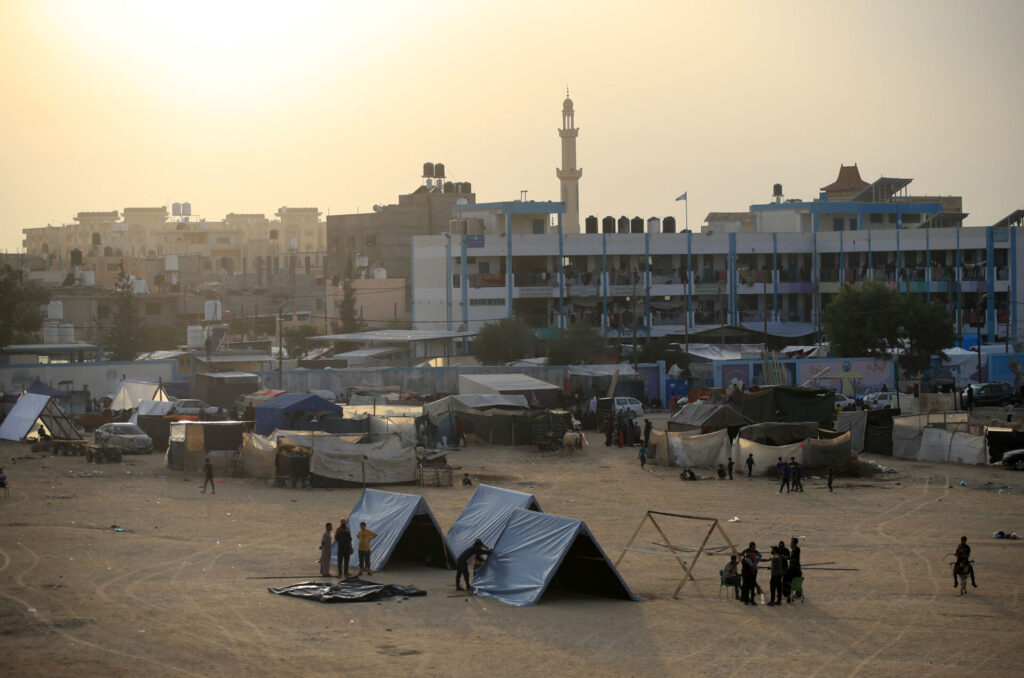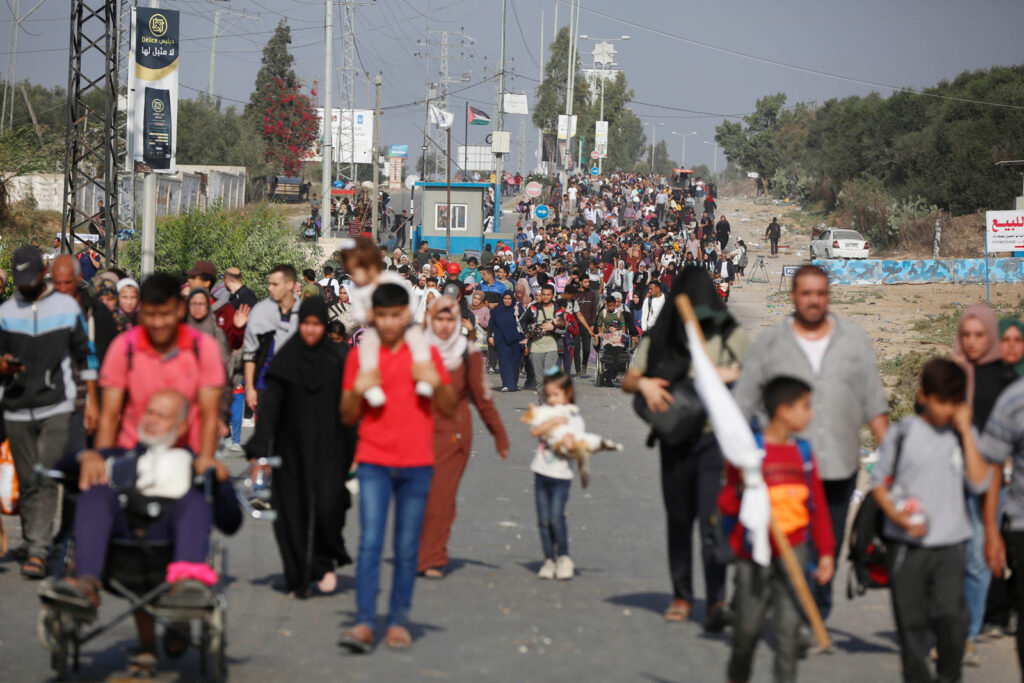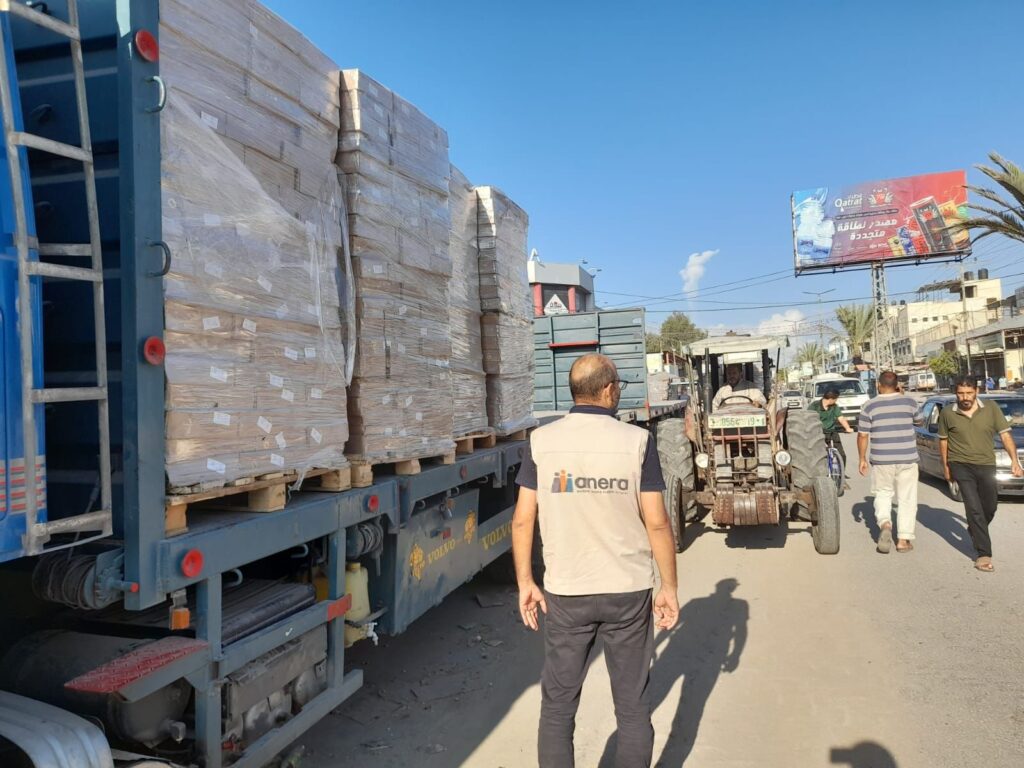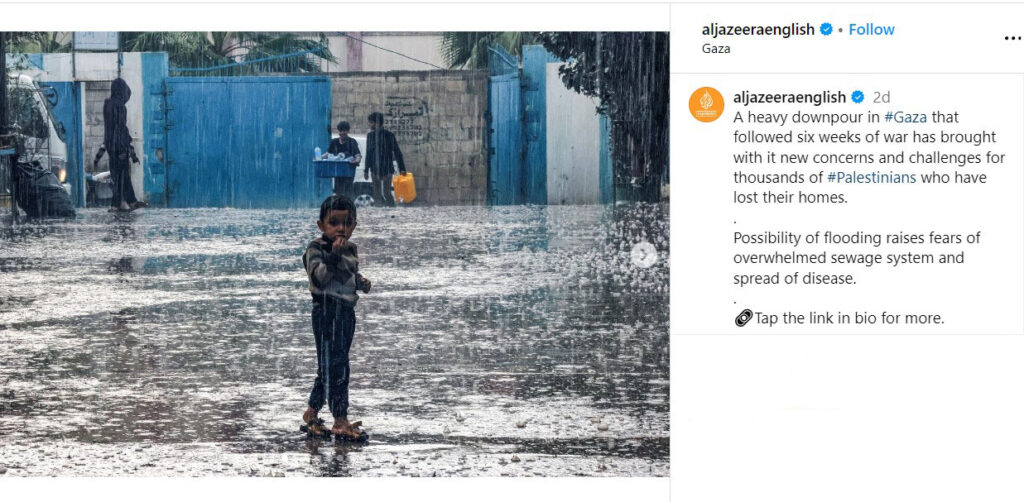Rain and Cold Compound Gaza’s Misery
With cold weather and rain storms predicted for this weekend, the suffering in Gaza will reach new levels of terrible. The war, likely to soon be the bloodiest in the 75-year Israeli-Palestinian conflict, has brought unprecedented challenges over the past 42 days. The arrival of the rainy season now compounds the misery displaced families are experiencing.


Displacement and Desolation
In the wake of intense bombings and a ground invasion, two-thirds of Gaza’s population have fled their homes, seeking refuge from the attacks. The first waves of displaced Gazans who moved from the north to the south were able to move into UN schools-turned-shelters or stay in homes with relatives, friends or generous strangers. Over the past 12 days, however, after Israel issued more evacuation orders, some 200,230 more people moved from the north to the south.


Numbers of displaced in shelters continued to grow until they were filled well beyond capacity. The UN reports an average of 6,250 internally displaced persons per shelter – a staggering nine times beyond their intended capacity. Those who were not able to get into building shelters were stranded with nowhere to go. They have had to make due with makeshift tents, which do not provide adequate protection against rain and cold weather.
News outlets have been sharing footage of flooded tents outside UNRWA schools in Rafah, emphasizing the urgent need for humanitarian intervention. “All of these tents collapsed because of the rain,” lamented Iqbal Abu Saud to The Guardian, as she struggled to secure her family’s tent. “How many days will we have to deal with this?”
This is on top of the thirst, hunger, exhaustion, and illness that have been plaguing the lives of those who have lost everything. The lack of access to water, both for drinking and daily use, has led to malnutrition and famine.
“If our children do not die from war, they will die from the cold of winter and hunger,” one man at a UN shelter emphasized to Al Jazeera.
The Danger of Spreading Illness in Gaza
In the crowded shelters and makeshift tent communities, as families huddle together for warmth, the risk of waterborne diseases and bacterial infections intensifies. Overcrowding, the lack of proper sanitation, and the scarcity of clean water, create a breeding ground for illness. The most vulnerable are the children, who can, in a weakened state, easily succumb to these kinds of diseases.
Aid agencies warned this week that the exhaustion of fuel reserves meant the end of waste and sewage removal services, creating “a colossal escalation of health risks, including accelerated outbreaks of waterborne diseases” (AIDA). In the refugee camps and new UN school shelters alone, 400 tons of solid waste per day will accumulate (UNRWA).
On Instagram, Dr. Margaret Harris, WHO spokesperson, delivers a warning about the storm’s ramifications: “We’ve already got outbreaks of diarrheal diseases…well over 30,000 cases when we would normally expect 2,000 cases in the same period. This will just add further to the suffering.”
Healthcare and Humanitarian Organizations Struggle to Keep Responding
Humanitarian organizations, facing fuel shortages and restricted border access, find their efforts severely hampered. It is a daily challenge to provide basic services, including food and medicines through Egypt’s Rafah crossing, Gaza’s sole link to goods from the outside world. On November 16, the first fuel shipment was allowed into Gaza. It contained 23,000 liters and was designated for only UNRWA’s use. The supply does not begin to address the massive shortages. UNRWA, for instance, needs some 160,000 liters of fuel daily to run their humanitarian operations.
Today, November 17, UNOCHA reported no movement of goods at the Rafah border inside of Gaza, due to the backlog of aid from previous days. Without fuel, trucks and forklifts at the border cannot process the shipments. This means that no new shipments are coming in to offer a little relief – items such as tents, mattresses, water, food and so much more.


Hospitals and healthcare facilities in Gaza are under unimaginable stress. The healthcare system is basically running in a semi-collapsed state without sufficient fuel deliveries to power generators, incubators, and other lifesaving equipment. Surgeons are forced to operate under only the glow of phone flashlights. Of Gaza’s 35 hospitals, only nine are still functioning, and all at a limited capacity.
The remaining hospitals and healthcare centers are performing far beyond their intended capacities, caring for the sick and injured as well as serving as makeshift shelters – 137,000 people are sheltering in hospitals, healthcare centers, other public buildings, or in tents outside of these spaces. Heavy rain and floods make these already unacceptable living conditions even more life-threatening both for those sleeping outside and those sheltering inside the damaged healthcare buildings.
There is also a shortage of medicines and healthcare supplies of every sort.
Anera’s Team is Still Making an Impact
Anera has a dedicated team of 12 staff members who are working alongside volunteers, local partners, vendors, and suppliers. Together, these 450 individuals are on the ground delivering humanitarian aid in Gaza every day, despite shortages of all kinds, bombed roads, and electricity cuts. Their life-saving interventions include millions of meals served, tens of thousands of hygiene kits distributed, hundreds of thousands of medical treatments delivered and school shelters regularly cleaned. The Anera medical staff in Gaza is also hosting free healthcare days with doctors, nurses and medicines on hand near shelters. (Read our daily response log to learn more and to keep up-to-date.)
As limited fuel permits goods to move through the Rafah border again, Anera, with our partners, will be bringing in additional trucks that include food, medical supplies, water, tents, blankets, mattresses and more.
Gaza Needs Fuel Above All
Fuel is basically depleted in Gaza, which means nothing can move. Aid trucks can’t deliver tents and other supplies to keep people protected from the cold and rain. They also can’t distribute water, food and medical supplies. Without fuel, there is no electricity to power healthcare facilities or pump and purify water. These are just the basics for maintaining life.
OUR BLOG
Related
Joint Statement 200+ NGOs call for immediate action to end the deadly Israeli distribution scheme (including the so-called Gaza Humanitarian Foundation) in Gaza, revert to the existing UN-led coordination mechanisms, and lift the Israeli government’s blockade on aid and commercial…

